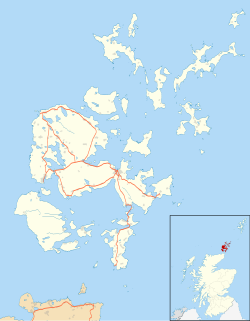This article relies largely or entirely on a single source .(November 2023) |
| Herston | |
|---|---|
 View along the street where cottages overlook Widewall Bay | |
Location within Orkney | |
| OS grid reference | ND420915 |
| Civil parish | |
| Council area | |
| Lieutenancy area | |
| Country | Scotland |
| Sovereign state | United Kingdom |
| Post town | ORKNEY |
| Postcode district | KW17 |
| Dialling code | 01856 |
| Police | Scotland |
| Fire | Scottish |
| Ambulance | Scottish |
| UK Parliament | |
| Scottish Parliament | |
Herston is a village on South Ronaldsay, Orkney, Scotland, United Kingdom. Herston is historically a fishing village but its only industry to speak of is Herston Stained Glass, now that Herston Hikers Hostel is now inactive.
The video for the Eurythmics song, "Here Comes the Rain Again", was partially filmed in Herston, at the wreck of the WWI-era ship, Monarch. [1]
